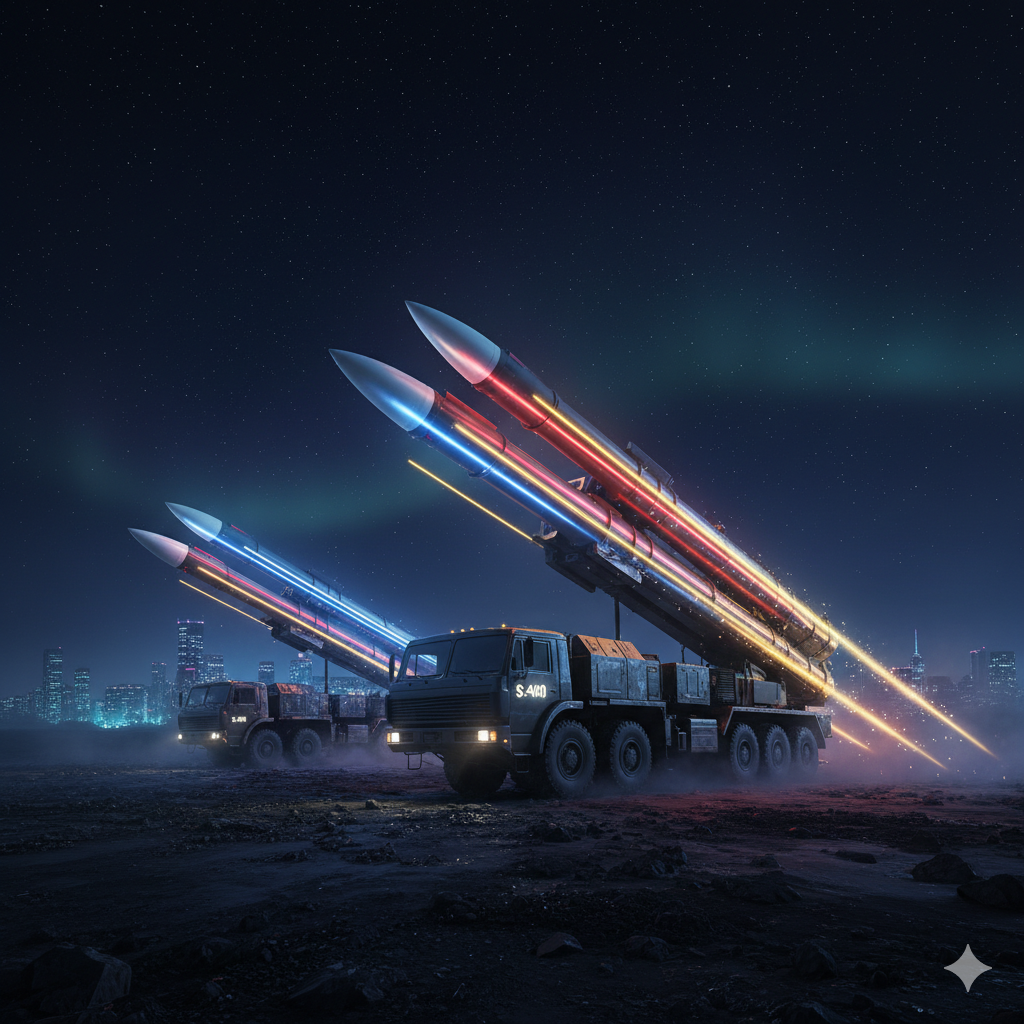Introduction
In modern warfare, air defence systems are indispensable tools for safeguarding national airspace and critical assets from aerial threats. The evolution of these systems—from simple anti-aircraft guns to advanced surface-to-air missile (SAM) networks—reflects the changing nature of aerial combat. Among all the contemporary air defence systems, the S-400 Triumf, developed by Almaz-Antey for the Russian Armed Forces, stands out as one of the most technically advanced and strategically valuable systems in the world.
The S-400, known by NATO as the SA-21 Growler, has redefined long-range air defence through its combination of advanced radar technologies, multi-missile capability, high mobility, and network-centric warfare adaptability. Its integration of multiple missile types, long detection range, and the ability to engage a diverse array of aerial threats make it a formidable shield that many countries aspire to acquire.
This article explores in depth the technical superiority of the S-400 compared to other modern systems like the Patriot PAC-3 (USA), THAAD, and Aegis BMD, examining how its radar suite, missile systems, tracking capacity, and operational flexibility make it a benchmark in modern air defence.
1. Evolution of the S-400 System
The S-400 system evolved from its predecessor, the S-300 series, with significant improvements in range, radar sophistication, target-tracking capabilities, and response time. Development began in the 1990s, and the system officially entered service with the Russian military in 2007. The goal was to design a comprehensive defence platform capable of neutralizing all modern aerial threats—including aircraft, UAVs, cruise missiles, and ballistic missiles—under challenging combat environments.
Unlike many western systems that are optimized for specific threat types, the S-400 was conceived as an integrated, multi-layered system capable of engaging multiple categories of targets simultaneously. This philosophy of “all-in-one” defence gives it a unique technological edge.
2. Multi-Layered Engagement Capability
The S-400 can employ four different types of missiles, each designed for a specific engagement envelope:
- 40N6 Missile: Longest-range interceptor with a reach up to 400 km, capable of targeting early-warning aircraft (AWACS), bombers, and strategic assets.
- 48N6DM Missile: Medium-to-long-range interceptor with a range of 250 km for high-altitude targets.
- 9M96E2 Missile: Medium-range, highly agile missile designed to intercept maneuvering aircraft and cruise missiles within 120 km.
- 9M96E Missile: Short-range missile optimized for drones and low-flying targets up to 40 km.
This diverse missile composition allows a single S-400 battery to defend against a full spectrum of aerial threats, from low-altitude drones to high-speed ballistic missiles.
Why This Is Technically Superior
- It eliminates the need for separate systems for different ranges.
- Enables simultaneous engagement of short-, medium-, and long-range targets.
- Allows efficient use of interceptors, reducing operational costs.
- Creates overlapping defence zones—ensuring no target escapes detection or interception.
No other operational system in the world currently integrates such a broad range of missile types within a single platform.
3. Advanced Radar and Detection Suite
A defining characteristic of the S-400 is its multi-layered radar complex that provides exceptional detection, tracking, and engagement capabilities.
Key Radars:
- 91N6E Big Bird Radar:
- Long-range surveillance radar capable of detecting aircraft up to 600 km away.
- Tracks up to 300 targets simultaneously.
- 92N6E Grave Stone Radar:
- Fire-control radar that guides missiles toward their targets.
- Operates in the X-band, offering high precision and resistance to jamming.
- 96L6 All-Altitude Detector:
- Designed to detect low-flying targets and stealth aircraft, filling coverage gaps.
- Designed to detect low-flying targets and stealth aircraft, filling coverage gaps.
- 40V6M Mast Radar:
- Provides high-elevation scanning for mountainous or obstructed terrain.
Technical Advantages:
- Multi-frequency operation: Combines L-band, S-band, and X-band frequencies, enabling detection of stealth aircraft designed to evade specific radar frequencies.
- Data fusion: Merges inputs from various radars to form a unified and accurate air picture.
- Electronic counter-countermeasures (ECCM): Enhances resistance to electronic jamming and spoofing.
- Target prioritization: Automatically categorizes threats based on speed, altitude, and trajectory.
In comparison, the American Patriot system mainly relies on a single radar (AN/MPQ-65), limiting its situational awareness and range diversity.
4. Missile Guidance and Interception Accuracy
The S-400 missiles employ a combination of semi-active and active radar homing guidance systems. In the mid-course phase, missiles receive guidance from the ground radar; during the terminal phase, onboard active radar seekers take control, improving hit accuracy.
Technical Features:
- Hit-to-Kill Probability: Estimated at over 90% for aerodynamic targets and around 80% for ballistic missiles.
- Interceptor Speed: Missiles can travel at speeds up to Mach 14, significantly reducing enemy reaction time.
- Target Engagement Altitude: Capable of hitting targets flying at altitudes between 5 meters and 30 kilometers.
- Simultaneous Engagement: A single S-400 battalion can engage up to 36 targets with 72 missiles at once.
Why This Matters:
High missile speed and precision make the S-400 ideal for intercepting fast-moving, maneuverable targets. Its combination of command guidance and active homing ensures successful interceptions even under intense electronic warfare conditions.
5. Stealth Detection and Anti-Stealth Capability
The S-400 radar network’s ability to detect low radar cross-section (RCS) aircraft gives it a distinct edge against stealth fighters such as the F-22 Raptor and F-35 Lightning II.
- L-band radars can detect stealth aircraft that are optimized to evade higher-frequency radars.
- The 96L6 and 91N6E radars can spot incoming stealth targets at considerable distances before they reach weapon release range.
- By networking with airborne and ground-based sensors, the S-400 can “triangulate” stealth aircraft positions even if radar returns are faint.
In comparison, many Western systems like Patriot PAC-3 are optimized for traditional radar signatures and may require integration with separate stealth-tracking systems to achieve similar performance.
6. Mobility and Deployment Flexibility
Mobility is another cornerstone of the S-400’s superiority. Each S-400 launcher is mounted on an 8×8 or 10×10 heavy-duty vehicle (typically BAZ or MAZ chassis). The system can be fully deployed and ready to fire within 5–10 minutes.
Mobility Features:
- 360° coverage without repositioning radars.
- Autonomous power systems allow off-grid operation.
- Rapid redeployment enhances survivability against enemy strikes.
- Can operate in extreme climates ranging from –50°C to +50°C.
This level of mobility enables the S-400 to perform shoot-and-scoot operations, making it extremely hard for enemies to target its radar or launch units with anti-radiation missiles.
7. Electronic Warfare Resistance
In modern conflict, defeating air defence systems often begins with electronic jamming. The S-400 is designed with advanced ECCM (Electronic Counter-Countermeasure) capabilities that ensure continuous operation even in electronically contested environments.
Technical Highlights:
- Frequency hopping technology to avoid jamming.
- Redundant communication channels for secure data transmission.
- Passive detection capability: even if radars are off, the system can use passive sensors to detect enemy emissions.
- Selective emission control allows radars to emit in bursts, reducing detectability.
In comparison, Western systems like THAAD rely heavily on satellite and network connectivity, making them more vulnerable to communication disruptions.
8. Integration and Network-Centric Warfare
The S-400 is not an isolated unit; it is designed to integrate seamlessly with other Russian air defence systems, such as:
- Pantsir-S1 for close-range defence.
- S-300 systems for medium-range coverage.
- A-50 AWACS aircraft for airborne target detection.
This hierarchical integration enables the S-400 to operate as part of a unified air-defence network, sharing data and tracking across platforms. Such multi-tiered defence is often described as an “umbrella of protection”, providing unmatched situational awareness and engagement flexibility.
While Western systems like Aegis and Patriot can be integrated through NATO networks, they generally rely on external systems for coordination, whereas the S-400’s integration is built-in at the design level.
9. Comparison with Other Global Systems
| Parameter | S-400 Triumf (Russia) | Patriot PAC-3 (USA) | THAAD (USA) | Aegis BMD (USA) |
|---|---|---|---|---|
| Max Range | 400 km | 160 km | 200 km (for BMD) | 250 km (SM-3) |
| Altitude | Up to 30 km | Up to 24 km | Up to 150 km | 250 km (exo-atmospheric) |
| Missile Types | 4 (short to long range) | 1 main interceptor | 1 interceptor | Multiple naval interceptors |
| Targets | Aircraft, Cruise & Ballistic Missiles | Mainly aircraft & tactical missiles | Ballistic missiles | Ballistic & cruise missiles |
| Radar | Multi-band (L/S/X) | Single-band (X-band) | X-band | S-band |
| Setup Time | 5–10 min | 25 min | 30 min | Naval system |
| Simultaneous Engagements | 36 targets (72 missiles) | 9 targets | 20 targets | Multiple (naval) |
| Stealth Detection | Yes | Limited | Moderate | Good (with AWACS) |
From the comparison, it is clear that the S-400 provides the widest operational envelope—handling multiple target types, longer engagement ranges, and quicker setup than most competitors.
10. Strategic and Operational Advantages
a) Cost Efficiency
Despite its advanced technology, the S-400 remains more cost-effective than Western counterparts, allowing nations to deploy multiple batteries without astronomical budgets.
b) Independence from Satellite Networks
Unlike THAAD or Aegis, which rely on U.S. satellite data links, the S-400 can operate autonomously using its ground-based sensors and command units.
c) Psychological Deterrence
Possession of the S-400 creates a psychological barrier for enemy aircraft and missile planners, as it significantly complicates their mission planning. It extends the defensive perimeter hundreds of kilometers beyond national borders, effectively deterring hostile incursions.
11. Limitations and Challenges
While the S-400 is technologically superior in many respects, it is not without challenges:
- Operational complexity: Requires skilled personnel and continuous training.
- Dependence on radar visibility: Terrain masking or electronic deception can reduce efficiency.
- Integration with non-Russian systems: Countries using Western platforms may face challenges integrating the S-400 due to different communication protocols.
However, these limitations are more logistical than technological. In terms of raw performance, the S-400 remains unmatched.
12. The Global Appeal of the S-400
Countries like India, China, and Turkey have invested heavily in acquiring the S-400, despite political pressure and sanctions threats. India’s acquisition under the Triumph deal symbolizes its intent to modernize air defence and enhance deterrence against hostile aerial incursions.
The system’s popularity stems from:
- Its independence from Western control systems.
- Proven performance in complex environments.
- Strategic value as both a defensive and diplomatic asset.
13. The Road Ahead: S-500 and Beyond
Russia has already begun developing the S-500 Prometey, an even more advanced successor to the S-400, with exo-atmospheric interception capability and improved radar sensors. However, until the S-500 is fully operational and exported, the S-400 remains the most advanced and widely deployable long-range air defence system in existence.
Conclusion
The S-400 Triumf stands as a testament to the sophistication of modern Russian defence engineering. Its multi-missile flexibility, radar diversity, stealth detection, mobility, and EW resistance together create a system that surpasses almost every other air defence platform currently available.
While the Patriot, THAAD, and Aegis systems each excel in specific domains, none can match the all-encompassing versatility and integrated design philosophy of the S-400. It is a true “umbrella defence” system that redefines how nations secure their skies in the age of stealth aircraft and hypersonic threats.
For countries seeking autonomy, long-range protection, and deterrence, the S-400 remains the gold standard of air defence technology — a fusion of engineering excellence and strategic foresight that continues to dominate the global defence landscape.




